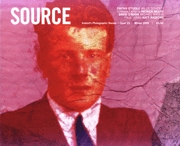Dead House UR
'Dead House UR' by Gregor Schneider was at The Douglas Hyde Gallery 18th October - 25th November 2000
Review by Justin Carville
Issue 25 Winter 2000
View Contents ▸
Gregor Schneider's Dead House UR is made up of an installation of some three hundred largely black and white photographs with a number of sculptural pieces such as Gravestone, Treasure Box (head, stomach and gut) and Negative Stone. These are accompanied by a twenty minute video screening of the artist struggling to crawl through the various orifices that lead to his installations in the Dead House's constructed spaces. As the artist grunts and groans working his way through the house with video camera in hand he is excreted from one space to another. The bulk of the exhibition however is made up of the large clusters of photographs reproducing various sections and installations of the house.
Photographs have a paradoxical role in the exhibition, they are in every respect secondary objects. That the artist's works exist, have been constructed and reside in the House is not in question. The photographs are not discussed as photographs, their role is that of the document. The place of the photograph in the context of Schneider's work is in the archive, it is a practical image providing information about the artist's work, the environment in which it is constructed and the form it takes. Described as Amateur Photographs Between Dead House UR, the photographs are black framed with black borders and signed and dated. They are presented as what might be described as classical or traditional documentary images. Despite this presentation however the photographs retain their secondary status. The photographs exist only as documents fulfilling their promise. We sit, drink coffee and look out of the window UR10, Rotating Coffeeroom 1993
We sit, drink coffee and look out of the window UR10, Rotating Coffeeroom 1993
In an interview with Ulrich Loock, Gregor Schneider remarked that he had a desire to work outside of his house in Rheydt, to produce work outside of the confined space that has provided both a raw material and a domesticated exhibition space for his sculptural installations for over a decade. For Schneider the installations produced out of the house have become independent of the structure itself, the insulated atmosphere controlled by the artist has become disconnected from the physical structure of the building out of which it is constructed. Just as it was out of necessity that his artistic practice has evolved out of the house in Rheydt, his desire to work outside of it may also be due to a necessity, a necessity to find a new space in which to produce his work.
The dilemma faced by Schneider is that his art of attrition, his wearing away of the house's functional spaces has meant that his work in the house may come to an indefinable conclusion, reaching a point where as he remarks the work either 'pushes me out of the house or swallows me up all together'. Schneider's sculptural installations have consumed the house to such an extent that to document his work there is almost an impossible project. Schneider goes on to remark: 'There is no way of fully documenting what has happened in the house the only way would be to measure the hidden spaces. No-one could get to the original structure any more without systematically drilling apart and destroying the house. The layers of lead mean you couldn't even x-ray it.'
The impossibility of documenting the installations within the house's narrow passageways and corridors is of course to deny the promise of photography, the promise of reproduction. This disavowal of the promise of photography is not however a reality, rather it is an anxiety, a fear of producing an object that is not reproducible. This may seem a strange concern for Schneider, as he does not produce sculptures or installations to be photographed as does say Andy Goldsworthy, yet photography is the vehicle through which his sculptural installations are exhibited. For Schneider's work to be re-presented as it is in The Douglas Hyde Gallery, the photograph has to fulfil its promise.
Other articles by Justin Carville:
Issue 24: Will the Real History of Photography Please Stand Up? [Feature] ▸
Issue 27: The History of the Solitary Lighthouse Keeper [Review] ▸
Issue 27: Each Wild Idea: Writing, Photography, History by Geoffrey Batchen [Book Review] ▸
Other articles on photography from the 'Documentary' category ▸






